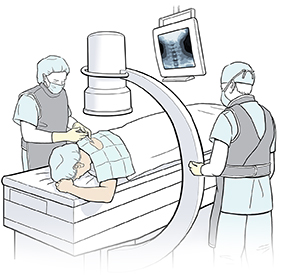Cervical Epidural Injection: Your Experience
Cervical epidural injection is a treatment for certain types of neck pain. During this procedure, medicine is injected deep into your neck near your spine. The injection helps the healthcare provider find the source of your pain. It can also help ease your pain and soreness for a short time or a long time. But it does have some serious risks.
The injection can be done in your provider's office. Or it may be done in a hospital or surgery center. You’ll be asked to fill out some forms, including a consent form. You may also be examined.
Before you agree to this procedure, make sure to ask the healthcare provider:
-
Why do I need this procedure?
-
Are there any alternatives?
-
How many times have you done this procedure?
-
What are the risks?
-
When will I see the results?
-
Will the medicine in this injection interact with other medicines I am taking?
If you don't feel OK asking these questions, ask a family member or friend to ask them. The answers are vital to your health and safety.
Getting ready for your treatment
-
Before treatment, tell your healthcare provider what medicines you take. This includes prescription and over-the-counter medicines. It includes aspirin and any vitamins, herbs, and other supplements. Ask if you should stop taking any of them before treatment.
-
Tell your provider if you're pregnant or could be.
-
Tell your provider if you're allergic to any medicines.
-
Follow any directions you're given for not eating or drinking before the procedure.
-
If asked, bring X-rays, MRIs, or other tests with you to your treatment.
During the procedure
You may be given medicine to help you relax. You'll lie on an exam table on your stomach or side, or sit in a chair. Stay as still as you can. During your treatment:
-
The skin over the injection site is cleaned. A medicine (local anesthetic) is used to numb the skin.
-
X-ray imaging (fluoroscopy) may be used to help your healthcare provider see where the injection needs to go. A contrast dye may be injected into the region to help get a better image.
-
The cervical epidural injection is given. It may contain a local anesthetic to numb the region, medicines to ease inflammation (steroids), or both.
 |
| A fluoroscope may be used to help the doctor see your spine during the procedure. |
Risks and possible complications
Other more serious complications have been reported. Talk to your healthcare provider about your risks.
After the procedure
-
You can likely go home about 1 hour after the procedure. Have a family member or friend drive you.
-
When the anesthetic wears off, your neck may feel more sore than usual. This is normal.
-
Rest and put ice or a cold pack on the area for 20 minutes. Do this a few times during the first day. To make an ice pack, put ice in a plastic bag that seals at the top. Wrap the bag in a thin towel or cloth. Don't put ice or an ice pack directly on the skin.
-
The steroids most often start to work in a few days.
-
Ask your healthcare provider when it’s OK to go back to work.
When to call your healthcare provider
Call your healthcare provider right away if you have:
-
Fever of 100.4°F (38°C) or higher , or as advised by your healthcare provider
-
Nausea
-
Severe headaches
-
Arm weakness or numbness that gets worse
-
Trouble swallowing
-
Pain that gets much worse
Online Medical Reviewer:
Jimmy Moe MD
Online Medical Reviewer:
Ronald Karlin MD
Online Medical Reviewer:
Tara Novick
Date Last Reviewed:
10/1/2021
© 2000-2024 The StayWell Company, LLC. All rights reserved. This information is not intended as a substitute for professional medical care. Always follow your healthcare professional's instructions.